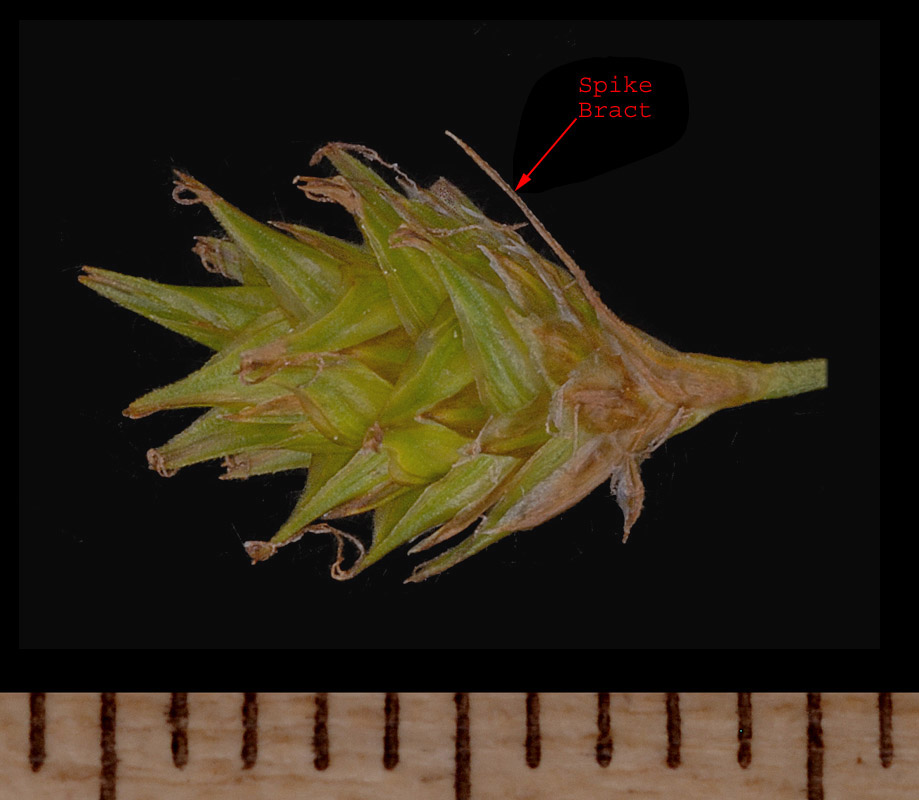 | Stigmas 2; achenes lenticular. NOT
[Stigmas 3; achenes three-sided, occasionally terete, though their shape
may be concealed by flattened perigynia.] |
 | Spikes 2 or more per culm, terminal
and lateral; spike bracts present on lateral spikes; lowest spike bracts
usually evident, often conspicuous, even in compact heads composed of
densely bunched and indistinguishable spikes (except in C. maritima,
C. chordorrhiza and C. microptera). NOT [Spikes 1 per
culm, terminal; spike bracts absent] |
 | Individual spikes distinguishable in
an open inflorescence, or indistinguishable in a compact head; spikes in
any one inflorescence alike in appearance due to their similar
composition (i.e. all are gynecandrous, androgynous, pistillate or
staminate), sessile. NOT [Individual spikes distinguishable in an open
inflorescence (densely bunched in C. bicolor); spikes in any one
inflorescence either markedly different in appearance (with terminal
spike staminate and lateral spikes pistillate), or subtly different in
appearance (with terminal spike gynecandrous and lateral spikes
pistillate), sessile or stalked.] |
 | Culms loosely to densely cespitose
(occasionally mat-forming rather than in discrete clumps); rhizomes, if
present, usually short with culms arising close together along them.
NOT [Culms single, or a few together, well-spaced along
conspicuous rhizomes or stolons.] |
 | Spikes gynecandrous, (terminal
spikes may be staminate in SK material of C. mackenziei;
pistillate or staminate spikes occur in Sect. Stellulatae, a
group distinguished by spongy tissue filling lower one-third to one-half
of the perigynium); if heads have indistinguishable spikes, the heads
are usually +/- as wide as they are long and usually widest in middle or
toward base. NOT [Spikes
androgynous, (lateral spikes occasionally pistillate in C. prairea);
if heads have indistinguishable spikes, the heads are usually oblong to
elongate in shape.] |
 | Lower 3 or 4 spike bracts usually
scale-like or bristle-like; if lowest is long and leaf-like, then it is
shorter than half the culm length or it appears to be an extension of
the culm to which inflorescence is attached laterally (as in C.
athrostachya); perigynia various.
NOT [Lower 3 or 4 spike bracts long, pale-green and leaf-like;
lowest bract 5-15 (20) cm long, usually half to fully as long as culm
below inflorescence; perigynia 5 mm long or longer, narrowly
lanceolate.] |
 | Perigynium margins flattened as a
narrow or wide wing for all or part of perigynium length (wing reduced
to raised thickened nerve along body in C. adusta); mature achene
narrower than perigynium body; beak present (though may be ill-defined);
neither perigynium base nor perigynium wall thickened with spongy
tissue. Section Ovales.
NOT [Perigynium distinctly wingless though margins may be
thickened as rounded or raised nerves; mature achene filling width of
perigynium body; perigynium base or wall thickened by spongy tissue or
cells; beak present or absent.] |
 | Spike bracts usually shorter, or a
bit longer than the inflorescence; if much longer then clearly
positioned beneath spike and appearing lateral rather than extending
culm-like beyond inflorescence. NOT
[Lowest spike bract distinctly longer than the inflorescence and
appearing to be an extension of culm with inflorescence attached to one
side rather than at tip.] |
 | Perigynia 5.2 mm long or less
(occasionally to 6 mm); distance from tip of beak to top of achene 3 mm
at most; inflorescence nodding or erect; species not confined to Cypress
Hills. NOT [Perigynia 6-8 mm long (occasionally as short as 5.5
mm); distance from tip of beak to top of achene 3.2–4.6 mm;
inflorescence stiffly erect; Cypress Hills only.] |
 | Spikes distinguishable, or
indistinguishable in a compact head; perigynia at most 3 times longer
than wide (C. praticola occasionally narrower but then pistillate
scales covering perigynia); other features variable.
NOT [Spikes distinguishable; perigynia usually 4 times longer
than wide, 3-4 (4.7) mm long and seldom over 1 mm wide; scales
distinctly shorter than perigynia; veins absent or faint on both
surfaces of perigynia.] |
 | Perigynium body orbicular, abruptly
contracted into beak, remaining green until turning tan at maturity;
pistillate scales one-third to two-fifths as wide as perigynia.
NOT [Perigynium body narrower, somewhat contracted or tapering into
beak; scale width and perigynium color variable.]
|

